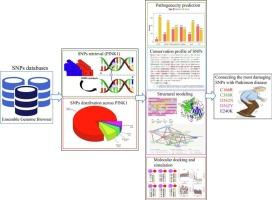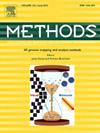人工智能增强预测与帕金森病相关的高危PINK1变异:整合多层生物信息学、MD模拟和深度学习
IF 4.3
3区 生物学
Q1 BIOCHEMICAL RESEARCH METHODS
引用次数: 0
摘要
帕金森病是一种常见的神经退行性疾病,许多基因的基因突变在其发病机制中起着重要作用。其中,PINK1基因(一种线粒体靶向丝氨酸/苏氨酸激酶1,可保护细胞免受应激诱导的线粒体功能障碍)的突变与常染色体隐性遗传性帕金森病有关。然而,确切的病因尚不清楚。因此,本研究旨在利用一系列生物信息学和深度学习工具,确定分布在PINK1基因激酶结构域的最具破坏性的非同义单核苷酸多态性(nssnp)及其结构和功能改变。接下来,为了发现这些突变对PINK1相互作用和结合亲和力可能产生的影响,我们进行了蛋白-蛋白相互作用和分子对接分析。最后,进行分子动力学(MD)模拟,观察致病snp在PINK1蛋白上随时间的稳定性和动态行为。我们的综合生物信息学和深度学习方法预测了5个snp (C166R, E240K, D362N, D362Y和C388R)作为破坏PINK1结构和功能的高风险候选。总之,我们认为这些变异的致病性可能为理解致病性nssnp参与PD的机制提供了重要线索,从而提高了未来对PD的诊断价值,并作为新药的潜在靶点。本文章由计算机程序翻译,如有差异,请以英文原文为准。

AI-augmented prediction of high-risk PINK1 variants associated with Parkinson’s disease: integrating multilayered bioinformatics, MD simulation, and deep learning
Parkinson’s disease is a prevalent neurodegenerative disease, in which genetic mutations in many genes play an important role in its pathogenesis. Among these, a mutation in the PINK1 gene, a mitochondrial-targeted serine/threonine putative kinase 1 that protects cells from stress-induced mitochondrial dysfunction, is implicated in autosomal recessive Parkinsonism. However, the exact etiology is not well understood. Therefore, this study aimed to identify the most damaging non-synonymous single-nucleotide polymorphisms (nsSNPs) distributed in the kinase domain of the PINK1 gene and their structural and functional alterations using a range of bioinformatics and deep learning tools. Next, to find the possible impact of these mutations on PINK1 interactions and binding affinities, a protein–protein interaction and molecular docking analysis were conducted. Finally, molecular dynamics (MD) simulations were performed to observe the stability and dynamic behaviour of the pathogenic SNPs on the PINK1 protein over time. Our integrated bioinformatics and deep learning approaches predicted 5 SNPs (C166R, E240K, D362N, D362Y, and C388R) as high-risk candidates for disrupting PINK1 structure and function. In conclusion, we propose that the pathogenicity of these variants may provide an important clue to understanding the mechanism by which pathogenic nsSNPs contribute to PD, thereby enhancing future diagnostic value for the disease and serving as potential targets for new drugs.
求助全文
通过发布文献求助,成功后即可免费获取论文全文。
去求助
来源期刊

Methods
生物-生化研究方法
CiteScore
9.80
自引率
2.10%
发文量
222
审稿时长
11.3 weeks
期刊介绍:
Methods focuses on rapidly developing techniques in the experimental biological and medical sciences.
Each topical issue, organized by a guest editor who is an expert in the area covered, consists solely of invited quality articles by specialist authors, many of them reviews. Issues are devoted to specific technical approaches with emphasis on clear detailed descriptions of protocols that allow them to be reproduced easily. The background information provided enables researchers to understand the principles underlying the methods; other helpful sections include comparisons of alternative methods giving the advantages and disadvantages of particular methods, guidance on avoiding potential pitfalls, and suggestions for troubleshooting.
 求助内容:
求助内容: 应助结果提醒方式:
应助结果提醒方式:


